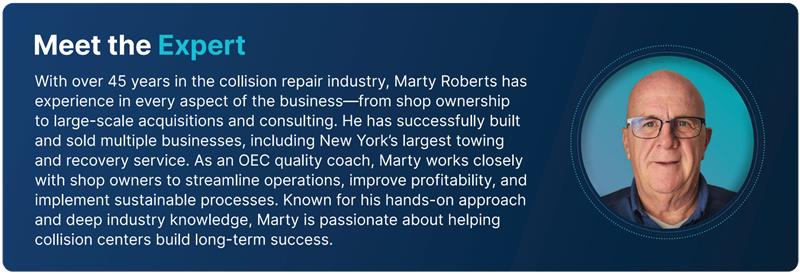In this conversation, Marty shares key insights on shop challenges, process improvement, and the impact of quality coaching.
Tell us a little about your background and how you got started in the collision repair industry.
I started in the body shop business at 14 years old, working at my dad’s shop. After five years, he decided to leave the industry, and at 19, I bought his collision center. From there, I grew it into four collision centers and a large towing and recovery business in Albany, NY. We became the largest towing vendor for the New York State Thruway system for about 20 years, and I also ran a fire truck repair and sales franchise.
Eventually, I sold the businesses, then spent five years acquiring collision and towing businesses nationwide. After moving to Ohio, I worked with a large manufacturer-certified collision network, gaining experience with BMW, Lexus, Toyota, Ford, GM, Chrysler, and Volkswagen Certifications. Later, I moved to Florida and joined SCI, which was later acquired by OEC. Since then, I’ve been working with shops, helping rebuild operations, improve processes, and boost profits.
What are some of the biggest challenges collision shops face today?
One of the biggest struggles is maintaining consistent processes. Many shops invest in new tools and software, but without a strong foundation, they struggle to integrate them. People will typically buy new technology, use it for a little while, and then stop. The problem is often that they don’t have the fundamentals in place. If the core shop operations are weak, no amount of new technology will fix it.
![]()
Another challenge is bridging the education gap between shop owners, technicians, and leadership. Many managers have spent their whole careers in collision repair but never received formal business training. What works is a humble, hands-on approach. If you go to shops with an open mind, they’ll show you what they need help with. Shops that embrace training and structured processes can significantly improve repair quality, reduce rework, and increase profitability.
What’s your approach to coaching and helping shops improve their operations?
I believe in starting at the ground level and working up. I call it the ‘crayon approach,’ figuring out who’s going to grow into the ballpoint pen and who’s ready for the computer. Not everyone has the same level of experience or comfort with new processes, so it’s about guiding them at their pace.
![]()
From there, we map out the workflow, identify bottlenecks, and build a system that works for their specific business.
Can you share an example of a shop that saw major improvements after working with a quality coach?
One of the best examples is a shop I workedwith in Georgia. They had a brand-new shop but zero process. The manager came from a service background, not collision, and was struggling to scale the business. Their margins were lower than they should have been, and the shop was chaotic. We started by organizing the shop layout for better efficiency, building a structured process for estimating, repairs, and quality control. Then, we evaluated the team to ensure the right people were in the right roles and set clear performance goals for every position. The result? Last month, they reported their highest gross margin since opening. Their operations are now smooth, their comeback rate has dropped dramatically, and their financials are finally under control.
What’s one piece of advice you’d give to a shop owner looking to grow their business?
Take an honest look at your shop and ask yourself whether there are areas where you know improvements are needed, if you have structured processes in place that your entire team follows, and if you’re getting the most out of the tools and resources
available. A fresh set of eyes can be incredibly helpful. Many shop owners are so caught up in the weeds of the day-to-day that they don’t see the gaps in their business. A good coach can identify blind spots, provide actionable strategies, and help create a sustainable plan for long-term success.

What’s the value of ongoing coaching?
Ongoing coaching makes all the difference when it comes to real, lasting improvements. It’s not just about fixing one problem and moving on. It’s about staying engaged, constantly refining processes, and adapting to whatever challenges come up. Shops that stick with coaching don’t just get a quick fix… they completely change the way they operate. Regular
check-ins keep everyone accountable, help new habits stick, and make it easier to fine-tune workflows as the business evolves. Over time, that consistency leads to better efficiency, higher-quality repairs, and a stronger bottom line.



